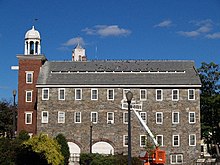|
David Wilkinson (machinist)David Wilkinson (January 5, 1771 – February 3, 1852)[1] was a U.S. mechanical engineer who invented a lathe for cutting screw threads, which was extremely important in the development of the machine tool industry in the early 19th century. Early lifeDavid Wilkinson was born at Smithfield, Rhode Island in 1771, the son of Oziel Wilkinson, a skilled blacksmith who moved his family to Pawtucket in the 1780s. About 1784, his father, Oziel began making anchors in Pawtucket for the emerging shipbuilding industry. The shop was powered by water from the Blackstone River, and was located on the grounds of the present-day Slater Mill Historic Site. Industrial careerIn 1790, Samuel Slater and his partners were interested in building a textile spinning mill in Pawtucket he sought the assistance of David Wilkinson and his father Oziel to produce the machinery for his new mill. They produced iron forgings and castings for Slater's carding and spinning machines.
In 1793 Slater's operations were moved from a clothier's shop near the Pawtucket Falls to a new mill, which today is part of the Slater Mill Historic Site.[3] In 1795 Oziel Wilkinson built a rolling and slitting mill just south of Slater's cotton mill. Both mills were powered with water from the same trench. Wilkinson latheTextile machinery manufacturer and scientific writer Zachariah Allen had the following to say about Wilkinson's lathe in 1861:
Ross Tompson (2009) on the importance of Wilkinson's lathe:[4]
On the versatility of his lathe Wilkinson said:[4]
An 1848 report from the Committee on Military Affairs to the U.S. Senate highlighted the importance of Wilkinson's invention, for which the patent had expired in 1812:
The report went on to say 'Wilkinson was the "true and undisputed author" of the lathe, and that it was "indispensable" for making firearms, and that public armories used 200 lathes based on the invention.[4] The report recommended a $10,000 reward, which he was given. Wilkinson failed to generate much income from his lathe. Records exist for the sale of one lathe and a few parts.[4] David Wilkinson's lathe is often compared to Henry Maudslay's which is believed to have been invented a few years before Wilkinson's. Maudslay's lathe used change gears which allowed it to cut threads of various pitches, without which Wilkinson's could only cut a fixed pitch. Wilkinson's lathe could handle heavier work.[5] Wilkinson MillIn 1810, the present-day Wilkinson Mill was built near their existing rolling and slitting mill and Slater's cotton mill. Three and one-half stories tall and constructed from field stones, it contained a machine shop on the first floor and cotton spinning mill on the upper floors. In 1829, during a depression in the textile industry, David Wilkinson was forced to sell his mills. He left Rhode Island settling initially in Cohoes, New York. In 1831 the mill was sold to William Field and Thomas LeFavour. The mill would later be used to produce woolen and knitted textiles. Between 1873 and 1887 Lorenzo P. Bosworth operated a machine shop in the mill. He produced machinery and tools for the leather and jewelry industries. A braiding company would occupy the second and third floors between 1884 and 1901. The Wilkinson Mill was later sold to the Pawtucket Electric Lighting Company. It was also used as a furniture warehouse during the 20th century. LegacyThe Wilkinson Mill was restored in the early 1970s as part of the Slater Mill Historic Site in Pawtucket, Rhode Island. The watermill site currently features a working 16,000-pound breastshot water wheel that powers, via gear systems and leather pulleys, various drive shafts to operate machinery.[6] In 1977, the American Society of Mechanical Engineers (ASME) designated the Wilkinson Mill in Pawtucket, Rhode Island a National Historic Mechanical Engineering Landmark.[7] See also
References
External links
|
